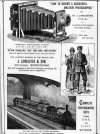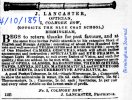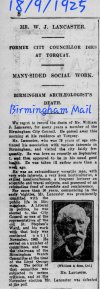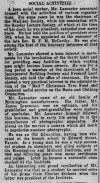-
Welcome to this forum . We are a worldwide group with a common interest in Birmingham and its history. While here, please follow a few simple rules. We ask that you respect other members, thank those who have helped you and please keep your contributions on-topic with the thread.
We do hope you enjoy your visit. BHF Admin Team
You are using an out of date browser. It may not display this or other websites correctly.
You should upgrade or use an alternative browser.
You should upgrade or use an alternative browser.
Lancaster makers of cameras
- Thread starter Heartland
- Start date
J. Lancaster and Son, optician and camera maker, of Irving Street, Birmingham.
Made wooden view cameras, among them several cameras for smaller plate formats.
Made wooden view cameras, among them several cameras for smaller plate formats.
- The 1/4-plate Instantograph was one of the better known.
- A very special model was the Gem Apparatus of 1880, a camera with twelve lenses to shoot the same subject twelve times at once.
From a link in another thread. A list of Lancaster cameras , and the information that the company was founded in 1835 and ceased trading in 1955.
https://collectiblend.com/Cameras/Lancaster/
https://collectiblend.com/Cameras/Lancaster/
toolate4regrets
knowlegable brummie
By 1900 Lancaster were the largest camera comany in the world, and the owner, William James lancaster is regarded as being the man who made amateur photography possible. The earliest record I have of them making cameras was from around 1854. Also if you fancy owning a Lancaster watch camera that @Stokkie mentioned, there is currently one on ebay at £41,470 (to be honest thats a fair price)
I think that Eastman Kodak might have had something to do with the development of amateur photography. "You Press the Button, We Do the Rest" The Kodak system enabled rolls to be sent away for development or handed to the chemist. Originally the entire camera was returned.
With a plate camera you have to develop the plate in the dark. Fantastic quality though, because of a big negative and easy to retouch.
With a plate camera you have to develop the plate in the dark. Fantastic quality though, because of a big negative and easy to retouch.
toolate4regrets
knowlegable brummie
Before Lancaster, photography was still expensive and compicated, Lancaster put photography in the hands of 100s of 1000s of people before Kodak came over to the UK... also Kodak took the invention of Alexander Parkes in Birmingham and had better marketing than Pumphrey brothers of Birmingham, which helped Kodak become successfulI think that Eastman Kodak might have had something to do with the development of amateur photography. "You Press the Button, We Do the Rest" The Kodak system enabled rolls to be sent away for development or handed to the chemist. Originally the entire camera was returned.
With a plate camera you have to develop the plate in the dark. Fantastic quality though, because of a big negative and easy to retouch.
The history of photography isn't a development from one person or company, but a synthesis of many knowledges and inventions. I think more of us will have owned a Box Brownie than will have a Lancaster. I've developed 4x5 sheet film in trays in my bathroom and the process demands absolute darkness, expensive film and chemicals. I was happy to use a commercial dark room. I know Lancaster used dry plates, but did they ever use roll film backs?Before Lancaster, photography was still expensive and compicated, Lancaster put photography in the hands of 100s of 1000s of people before Kodak came over to the UK... also Kodak took the invention of Alexander Parkes in Birmingham and had better marketing than Pumphrey brothers of Birmingham, which helped Kodak become successful
From The British Journal Photographic almanac :The history of photography isn't a development from one person or company, but a synthesis of many knowledges and inventions. I think more of us will have owned a Box Brownie than will have a Lancaster. I've developed 4x5 sheet film in trays in my bathroom and the process demands absolute darkness, expensive film and chemicals. I was happy to use a commercial dark room. I know Lancaster used dry plates, but did they ever use roll film backs?
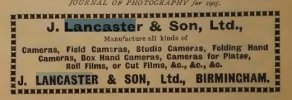
So it appears that they did
Thanks Mike. Appreciated.

